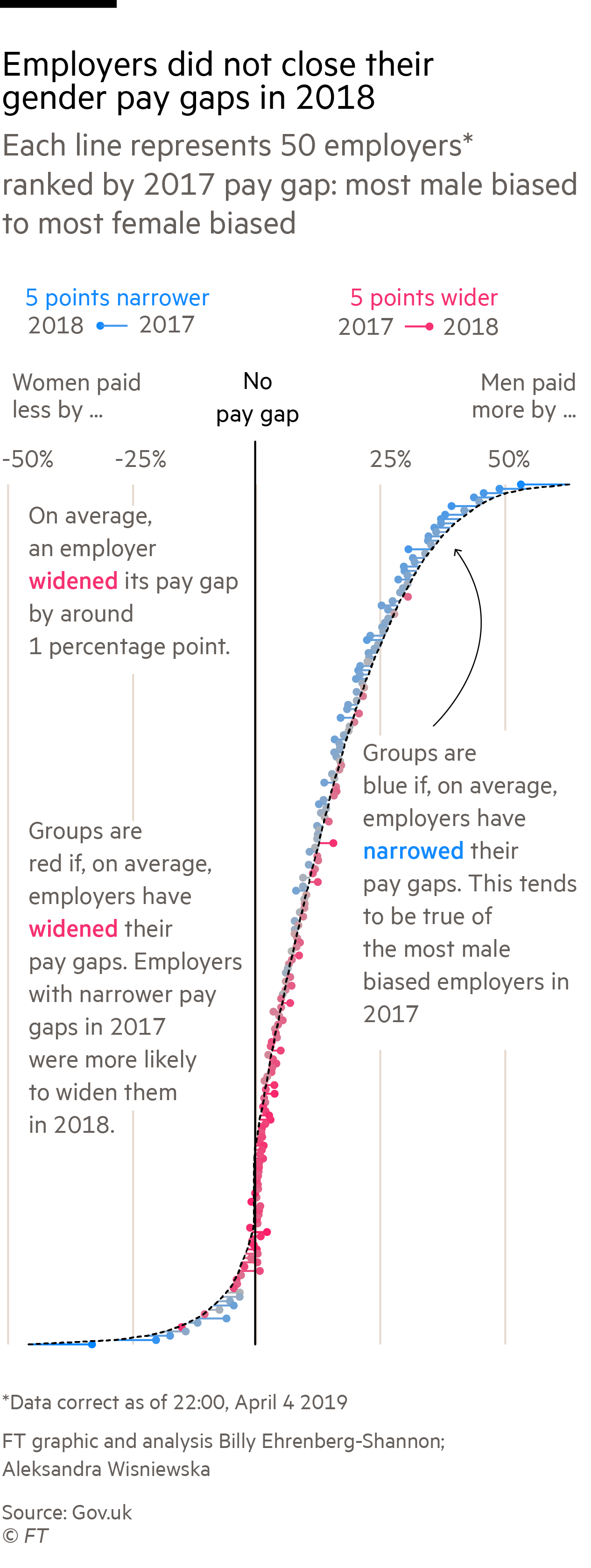The UK’s gender pay gap has barely budged in the year since the government imposed new disclosure rules, raising questions over whether its strategy of naming and shaming employers makes them improve their gender pay balance.
By the midnight deadline on Thursday, figures submitted by 10,428 employers show that the median pay gap this year was 11.9 per cent, compared to 11.8 per cent last year. There are still no sectors in the UK economy where women are paid the same as men.


“It’s a huge problem,” said Ann Francke, chief executive of the Chartered Management Institute, who added that the lack of change highlighted the need for changes in corporate culture, including measures to promote flexible working, fairer hiring and promotions.
She pointed out that Brexit was also holding back reform, with businesses preoccupied with the uncertainty surrounding the UK’s exit from the EU. “It’s literally sucking all the oxygen out of the boardroom,” she said, adding that the government should consider a system of penalties or fines to enforce change.
Gender pay reporting requirements were first introduced as part of the Equality Act 2010 and came into force in 2017. All UK employers with 250 or more staff — totalling some 10,500 employers with more than 15m employees — must report pay, bonuses and other data on March 31 for public sector entities and April 5 for private employers on the government’s gender pay website.
Policymakers hoped the transparency would shame large employers into taking swift action to narrow the difference between what they pay men and women.
However, the data show that the pay gap persists in all 20 sectors of the economy, with none paying women more than men on average. Of the employers that reported both last year and this year, 48 per cent (4,595) narrowed their gender pay gap while 44 per cent (4,230) widened it by an average of 3 percentage points.There were also 8 per cent (773) organisations that claimed to register no change at all in their pay gap. Of those, 476 claimed to have a median pay gap of 0 per cent.
Several employers saw large swings in their pay gaps between 2018 and 2019. One of the largest improvements was registered by Monzo bank, which reduced the gap from 48 per cent to 14 per cent. Monzo said its staff had more than trebled over the reporting period, from 90 to more than 300, with some women joining the bank in senior positions, and several being promoted.
School and academy trusts also saw big changes in their pay gaps, largely driven by the addition of new schools, many dominated by female staff. Many say they expect further swings over the next reporting period.
Companies where the pay gap increased pointed to changing staff levels, and the promotion of more men than women in the upper middle and top quartile of their workforce. Ashfords, a law firm whose pay gap went up from 15.8 per cent to 39.4 per cent, said the figures were driven by a large number of junior women joining the company, which offset the effect of women being promoted to senior positions.
“As we see the women who have joined within the lower quartile progress through the firm we expect that this gap will reduce significantly,” said Garry Mackay, Ashfords chief executive.
| ASH & LACY FINISHES | 100% |
| VIDA HEALTHCARE | 79.3% |
| SUFFOLK GP FEDERATION CIC | 74.8% |
| 2018 | 2019 | |
|---|---|---|
| REALISE FUTURES CIC | -14.9% | -90.7% |
| NEWSQUEST MEDIA GROUP | 7% | -82% |
| NEW MILLENNIA PAYROLL SERVICES | 11% | 74.3% |
The data show that women in the public sector fared worse than those in private companies, with the public sector pay gap increasing slightly from 16 per cent in 2018 to 16.7 per cent this year. The pay gap in the private sector held steady at 11 per cent.
The lack of change in the figures will add to calls for more muscular regulation surrounding gender pay. Under current rules employers are not required to provide details of how they will address the gender pay issue. Last year just 48 per cent of employers provided an action plan, according to the government estimates.
Earlier this year, the government rejected calls from parliament’s Business, Energy and Industrial Strategy committee to impose additional gender pay reporting measures, saying it hoped employers would take “inspiration” from the range of action plans others had produced.


The Equalities and Human Rights Commission, which enforces gender pay reporting, is required only to ensure employers report their figures, not to check the accuracy of the data submitted or the progress achieved. The EHRC is currently the subject of an inquiry by the parliamentary Women and Equalities committee, which is looking into its “known problems with enforcement”.
Geraldine Healy, professor of employment relations at Queen Mary University of London, warned that “change is unlikely without external pressure, whether from unions, women’s networks and pressure groups”. She added that it is ultimately up to the state to introduce financial sanctions on organisations that show no progress in closing the gender pay gap.
Victoria Atkins, minister for women, told parliament on Thursday that while most companies will not see a “dramatic reduction” in their gender pay gaps this year, “progress is being made”.
“Reporting is just the start,” she said, adding that forcing through such structural change “cannot be done overnight”.


For the average of the pay gaps of multiple companies, we have used a mean of medians. This is imperfect, but without individual salary information it is impossible to get a true average.
In our best/worst-performing sector analysis, we exclude sectors with fewer than 25 company submissions because a small sample size is more vulnerable to having its average skewed by outliers.
Data in the piece are accurate as of 00.01 Friday, April 5 2019.
Source: Gov.uk